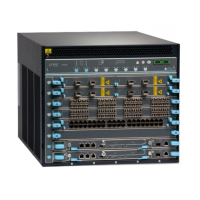•
Component redundancy circuitry
•
Control Board/Routing Engine mastership mechanism
•
Gigabit Ethernet switch that is connected to the embedded CPU complex on all
components
•
Control field-programmable gate array (FPGA)—Provides the Peripheral Component
Interconnect (PCI) interface to the Routing Engine
•
1000Base-T Ethernet controller—Provides a 1-Gbps Ethernet link between the Routing
Engines
•
Ethernet switch—Provides 1-Gbps link speeds between the Routing Engine and the
line cards
•
External clock interface—Allows BITS or GPS clock source input to the centralized
timing circuit, or allows centralized timing to be output to BITS or GPS
•
Circuits for chassis management and control
•
Power circuits for the Routing Engine and the Switch Fabric
•
SF moduleLEDs—Indicate system status. See “Switch Fabric Module LEDs in an EX9200
Switch” on page 35.
•
Ejector levers—Used for installing and removing the SF module
•
Captive screws—Secure the SF module in place
Related
Documentation
Installing an SF Module in an EX9200 Switch on page 232•
• Removing an SF Module from an EX9200 Switch on page 235
• Taking the Host Subsystem Offline in an EX9200 Switch on page 226
Host Subsystem in an EX9200 Switch
Switching and routing functionality, system management, and system control functions
of an EX9200 switch are performed by host subsystem. A host subsystem consists of a
Routing Engine functioning together with a Switch Fabric.
You can install either one or two host subsystems in the front panel of an EX9204 or an
EX9208 switch. A base configuration EX9204 and EX9208 switch has one host
subsystem. A redundant configuration EX9204 and EX9208 switch has a second host
subsystem.
You can install either twoor three host subsystems in the front panel of an EX9214 switch.
A base configuration EX9214 switch has two host subsystems. A redundant configuration
EX9214 switch has a third host subsystem.
Copyright © 2017, Juniper Networks, Inc.32
EX9208 Switch Hardware Guide

